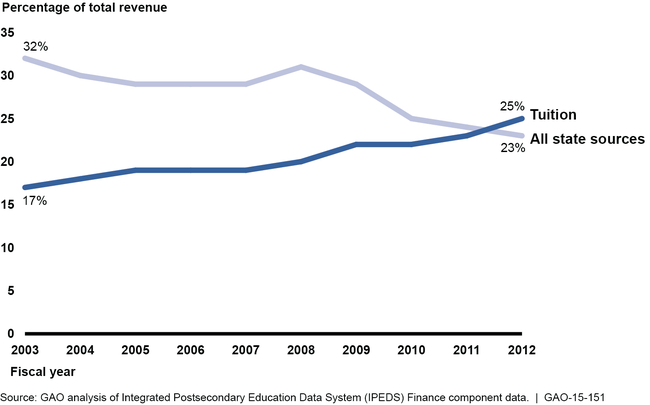Higher Education: State Funding Trends and Policies on Affordability
Highlights
What GAO Found
From fiscal years 2003 through 2012, state funding for all public colleges decreased, while tuition rose. Specifically, state funding decreased by 12 percent overall while median tuition rose 55 percent across all public colleges. The decline in state funding for public colleges may have been due in part to the impact of the recent recession on state budgets. Colleges began receiving less of their total funding from states and increasingly relied on tuition revenue during this period. Tuition revenue for public colleges increased from 17 percent to 25 percent, surpassing state funding by fiscal year 2012, as shown below. Correspondingly, average net tuition, which is the estimated tuition after grant aid is deducted, also increased by 19 percent during this period. These increases have contributed to the decline in college affordability as students and their families are bearing the cost of college as a larger portion of their total family budgets.
Public College Revenue from State Sources and Tuition, Fiscal Years 2003 through 2012

GAO found that federal support for higher education is primarily targeted at funding student financial aid— over $136 billion in loans, grants, and work-study in fiscal year 2013—rather than at programs involving states. GAO identified several potential approaches that the federal government could use to expand incentives to states to improve affordability, such as creating new grants, providing more consumer information on affordability, or changing federal student aid programs. Each of these approaches may have advantages and challenges, including cost implications for the federal government and consequences for students.
Why GAO Did This Study
There is widespread concern that the rising costs of higher education are making college unaffordable for many students and their families. Federal and state support is central to promoting college affordability; however, persistent state budget constraints have limited funding for public colleges. GAO was asked to study state policies affecting affordability and identify approaches to encourage states to make college more affordable.
This report examines, among other things, how state financial support and tuition have changed at public colleges over the past decade. It also examines how the federal government works with states to improve college affordability and what additional approaches are available for doing so. In conducting this work, GAO analyzed trends in state funding for public colleges, tuition, and state student aid using data from the U.S. Department of Education for all public sector colleges from fiscal years 2003 through 2012, the most recent data available at the time of this study. GAO also identified academic studies on state higher education policies and affordability published since 2011 and interviewed 25 academic experts and organizations in the fields of higher education or state policy. Finally, GAO reviewed Education programs and proposals and obtained perspectives from experts and organizations to identify approaches the federal government could use to incentivize state action.
Recommendations
GAO does not make recommendations in this report.
